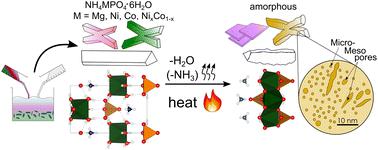Our official English website, www.x-mol.net, welcomes your
feedback! (Note: you will need to create a separate account there.)
Template-free synthesis of mesoporous and amorphous transition metal phosphate materials
Nanoscale ( IF 5.8 ) Pub Date : 2023-01-13 , DOI: 10.1039/d2nr05630e Stephanos Karafiludis 1, 2 , Ana Guilherme Buzanich 1 , Christian Heinekamp 1, 2 , Annett Zimathies 1 , Glen J Smales 1 , Vasile-Dan Hodoroaba 1 , Johan E Ten Elshof 3 , Franziska Emmerling 1, 2 , Tomasz M Stawski 1
Nanoscale ( IF 5.8 ) Pub Date : 2023-01-13 , DOI: 10.1039/d2nr05630e Stephanos Karafiludis 1, 2 , Ana Guilherme Buzanich 1 , Christian Heinekamp 1, 2 , Annett Zimathies 1 , Glen J Smales 1 , Vasile-Dan Hodoroaba 1 , Johan E Ten Elshof 3 , Franziska Emmerling 1, 2 , Tomasz M Stawski 1
Affiliation

|
We present how mesoporosity can be engineered in transition metal phosphate (TMPs) materials in a template-free manner. The method involves the transformation of a precursor metal phosphate phase, called M-struvite (NH4MPO4·6H2O, M = Mg2+, Ni2+, Co2+, NixCo1−x2+). It relies on the thermal decomposition of crystalline M-struvite precursors to an amorphous and simultaneously mesoporous phase, which forms during degassing of NH3 and H2O. The temporal evolution of mesoporous frameworks and the response of the metal coordination environment were followed by in situ and ex situ scattering and diffraction, as well as X-ray spectroscopy. Despite sharing the same precursor struvite structure, different amorphous and mesoporous structures were obtained depending on the involved transition metal. We highlight the systematic differences in absolute surface area, pore shape, pore size, and phase transitions depending on the metal cation present in the analogous M-struvites. The amorphous structures of thermally decomposed Mg-, Ni- and NixCo1−x-struvites exhibit high surface areas and pore volumes (240 m2 g−1 and 0.32 cm−3 g−1 for Mg and 90 m2 g−1 and 0.13 cm−3 g−1 for Ni). We propose that the low-cost, environmentally friendly M-struvites could be obtained as recycling products from industrial and agricultural wastewaters. These waste products could be then upcycled into mesoporous TMPs through a simple thermal treatment for further application, for instance in (electro)catalysis.
中文翻译:

介孔和无定形过渡金属磷酸盐材料的无模板合成
我们介绍了如何以无模板的方式在过渡金属磷酸盐 (TMP) 材料中设计介孔性。该方法涉及前体金属磷酸盐相的转化,称为 M-鸟粪石 (NH 4 MPO 4 ·6H 2 O, M = Mg 2+ , Ni 2+ , Co 2+ , Ni x Co 1− x 2+ )。它依赖于结晶 M-鸟粪石前体热分解为无定形且同时为介孔相,该相在 NH 3和 H 2 O 脱气过程中形成。介孔骨架的时间演化和金属配位环境的响应随后是原位和非原位散射和衍射,以及 X 射线光谱。尽管共享相同的前体鸟粪石结构,但根据所涉及的过渡金属获得了不同的无定形和中孔结构。我们强调了绝对表面积、孔形状、孔径和相变方面的系统差异,具体取决于类似 M-鸟粪石中存在的金属阳离子。热分解的 Mg-、Ni- 和 Ni x Co 1− x -鸟粪石的无定形结构表现出高表面积和孔体积(Mg 为 240 m 2 g −1和 0.32 cm −3 g −1,Mg 为 90 m 2 g − 1个Ni 为0.13 cm -3 g -1)。我们建议低成本、环保的 M-鸟粪石可以作为工业和农业废水的回收产品获得。然后可以通过简单的热处理将这些废品升级为介孔 TMP,以进一步应用,例如(电)催化。
更新日期:2023-01-13
中文翻译:

介孔和无定形过渡金属磷酸盐材料的无模板合成
我们介绍了如何以无模板的方式在过渡金属磷酸盐 (TMP) 材料中设计介孔性。该方法涉及前体金属磷酸盐相的转化,称为 M-鸟粪石 (NH 4 MPO 4 ·6H 2 O, M = Mg 2+ , Ni 2+ , Co 2+ , Ni x Co 1− x 2+ )。它依赖于结晶 M-鸟粪石前体热分解为无定形且同时为介孔相,该相在 NH 3和 H 2 O 脱气过程中形成。介孔骨架的时间演化和金属配位环境的响应随后是原位和非原位散射和衍射,以及 X 射线光谱。尽管共享相同的前体鸟粪石结构,但根据所涉及的过渡金属获得了不同的无定形和中孔结构。我们强调了绝对表面积、孔形状、孔径和相变方面的系统差异,具体取决于类似 M-鸟粪石中存在的金属阳离子。热分解的 Mg-、Ni- 和 Ni x Co 1− x -鸟粪石的无定形结构表现出高表面积和孔体积(Mg 为 240 m 2 g −1和 0.32 cm −3 g −1,Mg 为 90 m 2 g − 1个Ni 为0.13 cm -3 g -1)。我们建议低成本、环保的 M-鸟粪石可以作为工业和农业废水的回收产品获得。然后可以通过简单的热处理将这些废品升级为介孔 TMP,以进一步应用,例如(电)催化。













































 京公网安备 11010802027423号
京公网安备 11010802027423号